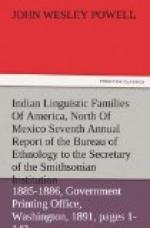= Kolush, Latham, El. Comp.
Phil., 401, 1862 (mere mention of family
with short vocabulary).
= Kaloshians, Dall in Proc. Am.
Ass., 375, 1885 (gives tribes and
population).
X Northern, Scouler in Jour. Roy.
Geog. Soc. Lond., XI, 218, 1841
(includes Koloshes and Tun Ghasse).
X Haidah, Scouler, ibid, 219, 1841 (same as his Northern).
= Klen-ee-kate, Schoolcraft, Ind. Tribes, V, 489, 1855.
= Klen-e-kate, Kane, Wanderings of an
Artist, app., 1859 (a census of
N.W. coast tribes classified by language).
= Thlinkithen, Holmberg in Finland Soc.,
284, 1856 (fide Buschmann,
676, 1859).
= Thl’nkets, Dall in Proc.
Am. Ass., 268, 269, 1869 (divided into
Sitka-kwan, Stahkin-kwan, “Yakutats").
= T’linkets, Dall in Cont.
N.A. Eth., I, 36, 1877 (divided into
Y[va]k’[-u]t[va]ts [Yak’utats],
Chilk[-a]ht’kwan, Sitka-kwan,
St[-a]khin’-kw[-a]n, Kyg[-a]h’ni).
= Thlinkeet, Keane, App. Stanford’s Comp. (Cent, and So. Am.), 460, 462, 1878 (from Mount St. Elias to Nass River; includes Ugalenzes, Yakutats, Chilkats, Hoodnids, Hoodsinoos, Takoos, Auks, Kakas, Stikines, Eeliknus, Tungass, Sitkas). Bancroft, Nat. Races, III, 562, 579, 1882.
= Thlinkit, Tolmie and Dawson, Comp.
Vocabs., 14, 1884 (vocab. of
Skutkwan Sept; also map showing distribution
of family). Berghaus,
Physik. Atlas, map 72, 1887.
= Tlinkit, Dall in Proc. Am.
Ass., 375, 1885 (enumerates tribes and
gives population).
Derivation: From the Aleut word kolosh, or more properly, kaluga, meaning “dish,” the allusion being to the dish-shaped lip ornaments.
This family was based by Gallatin upon the Koluschen tribe (the Tshinkitani of Marchand), “who inhabit the islands and the adjacent coast from the sixtieth to the fifty-fifth degree of north latitude.”
In the Koluschan family, Gallatin observes that the remote analogies to the Mexican tongue to be found in several of the northern tribes, as the Kinai, are more marked than in any other.
The boundaries of this family as given by Gallatin are substantially in accordance with our present knowledge of the subject. The southern boundary is somewhat indeterminate owing to the fact, ascertained by the census agents in 1880, that the Haida tribes extend somewhat farther north than was formerly supposed and occupy the southeast half of Prince of Wales Island. About latitude 56 deg., or the mouth of Portland Canal, indicates the southern limit of the family, and 60 deg., or near the mouth of Atna River, the northern limit. Until recently they have been supposed to be exclusively an insular and coast people, but Mr. Dawson has made the interesting discovery[63] that the Tagish, a tribe living inland on the headwaters of the Lewis River, who have hitherto been supposed to be of Athapascan extraction, belong to the Koluschan family. This tribe, therefore, has crossed the coast range of mountains, which for the most part limits the extension of this people inland and confines them to a narrow coast strip, and have gained a permanent foothold in the interior, where they share the habits of the neighboring Athapascan tribes.




